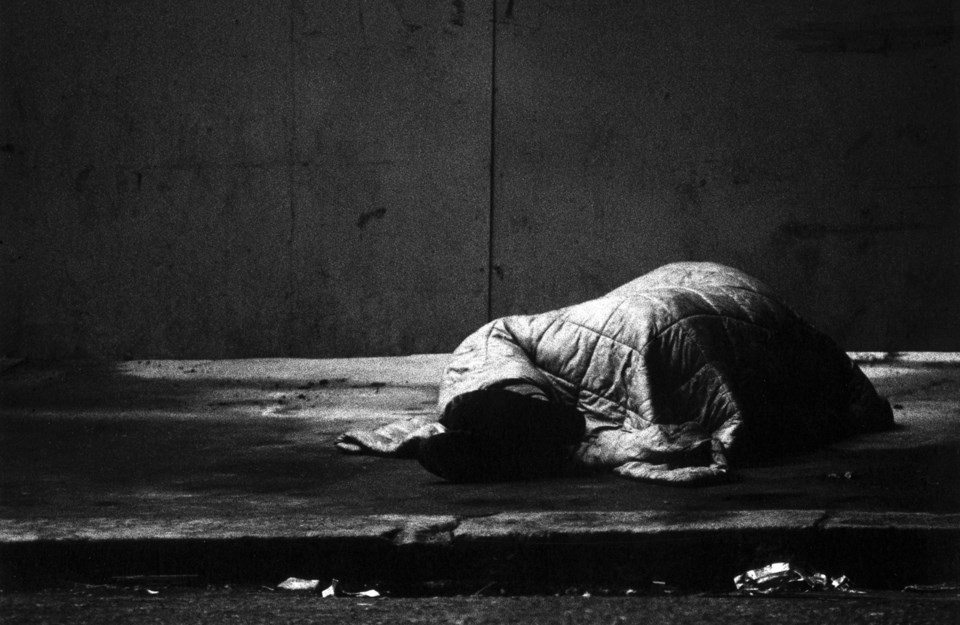New Westminster’s homeless population has grown by 25 per cent in the past three years.
Overall, the 2017 homeless count in Metro Vancouver found 3,605 homeless people in the region, which is a 30 per cent increase from the previous count in 2014. In New Westminster, 133 people were deemed to be homeless, an increase from the 106 individuals counted three years ago.
“It’s certainly not surprising to see the homeless numbers seeing a substantial increase in Metro Vancouver. Across the region, the average is 30 per cent across all the municipalities. There is some municipalities that have seen significant impacts, even doubled in their numbers,” said Mayor Jonathan Cote. “The increase in New Westminster, 25 per cent, is just below the regional average.”
While there’s work to be done locally to address homelessness, Cote noted that the number of the homeless people who have no shelter and are living on the streets in New West has gone down 12 per cent since the 2014 count. The homeless count attempts to reach people who are living on streets or in makeshift camps or are staying overnight in homeless shelters, transition houses and safe houses.
“I think that connects to the policies that the city has put in place that have really focused on trying to find supportive housing and transitional housing projects for people living on the street, because it’s a lot easier to deal with the challenging issues surrounding homelessness when there is a roof over your head as opposed to living on the streets,” Cote said in the decline in street homelessness in the city. “Although the numbers aren’t positive, both in the region and in New Westminster in terms of the growing homelessness population, we certainly do think it is a positive sign that the street homeless population is declining.”
Cote said the reason New Westminster has seen more positive numbers in terms of the homeless count over the past decade than some of its neighbouring municipalities is the fact it’s partnered with B.C. Housing and non-profits to create supportive and transitional housing in the city.
“We would definitely be calling for the provincial government and the federal governments for putting more resources to see more of these types of supportive housing units, not only in New Westminster, but across the Metro Vancouver region,” he said. “We are in constant contact with B.C. Housing here at the City of New Westminster to really see what availability do we have for affordable and supportive housing projects in New Westminster.”
Cote and Lisa Spitale, the city’s chief administrative officer, represented the city on a regional task force on homelessness. The task force recently outlined an action plan and recommendations in a position paper, Addressing Homelessness in Metro Vancouver, which included a recommendation that provincial and federal governments work with municipalities and community agencies to implement an immediate action plan by the end of 2017.
Addressing Homelessness in Metro Vancouver identifies 12 key priorities based on the goals of preventing people from becoming homeless, serving those who are homeless and finding pathways out of homelessness. Recommendations include building a strong social safety net for First Nations population, implementing policies and programs to enhance the transition of youth aging out of foster care, ensuring that an adequate support of affordable rental housing is available to meet the demand of those at risk of homelessness, shifting the focus from reactive to proactive measures to end homelessness.
“The reality is we have seen 16 years in a row with the homelessness numbers increasing in Metro Vancouver,” Cote said. “That is a pretty strong pattern over that period of time and we think there is not any one magic bullet solution to this but there’s a series of efforts that will require resources, both to deal with the immediate problem but also to deal with supporting people to transition out of homelessness. What’s also forgotten is the other end of the spectrum – how do we make sure we are setting up the programs to prevent people from becoming homeless in the first place.”
Cote said the region is ready to work with the provincial and federal governments and community agencies to implement the proposed action plan and address increasing homelessness in New Westminster and the region.
“The city has been very proactive in addressing homelessness and is one of the better resourced municipalities in terms of shelter capacity and supportive housing in Metro Vancouver,” said John Stark, the city’s senior social planner. “While the city has not seen the large encampments which are commonplace in other municipalities, the evidence suggests that the numbers are increasing in our city and that a coordinated reginal response involving all levels of government is warranted.”
Fast facts
* Rates of working poverty and homelessness in Metro Vancouver are among the highest in Canada, with 60,000 households spending more than half their income on shelter.
* About 4,000 people in the region have an immediate need for housing and are living on the streets, in their cars, in homeless camps, parks and forests or in a temporary shelter.
* Approximately five people become homeless in the region each week.
* The incidence of homelessness has increased annually for the past 15 years and is now considered a state of crisis.
* An estimated 80 per cent of homeless people suffer a chronic health issue, 49 per cent have an addiction and 34 per cent suffer from mental illness.
* While First Nations people comprise about three per cent of the region’s overall population, 31 per cent of homeless people are of First Nations descent.
* About 40 per cent of homeless people have been in foster care, 40 per cent were in the criminal justice system and 70 per cent experienced a past trauma or abuse.
* It’s estimated that it costs taxpayers $55,000 annually for each homeless person, or more than $200 milion annually across the region.
Facts courtesy of Addressing Homelessness in Metro Vancouver report.



